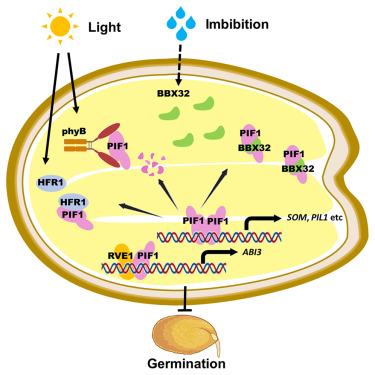BBX32 Protein: Role in Plant Growth and Stress Response
Why in the News?
Researchers at IISER Bhopal have discovered the critical role of a single protein, BBX32, in helping plant seedlings transition safely from darkness underground to sunlight above. This finding can revolutionise how we approach crop survival and early-stage plant development under challenging soil and climate conditions.

Background
BBX Proteins: BBX32 belongs to the B-box family of zinc finger transcription factors, known for regulating light signalling, seed germination, flowering time, and stress responses.
Germination Challenge: For a seedling, emerging from the soil is perilous. The soft shoot tip must be protected until it reaches the surface, typically through a protective hook formed by the hypocotyl.
Role of Hormones and Light: Plant hormones like ethylene and external cues like light synchronise complex molecular responses that guide this delicate process.
Feature: How BBX32 Functions in Plants
Protection:
- BBX32 ensures the hook remains closed during soil emergence, shielding the shoot tip.
- It delays premature opening, especially in rough soil conditions.
Activation Mechanism:
- Ethylene, produced under soil pressure, activates BBX32.
- In darkness, COP1 degrades BBX32, but ethylene slows this down.
- On light exposure, BBX32 becomes stable and accumulates on one side of the hook.
Molecular Cascade:
- BBX32 activates PIF3, which in turn stimulates HLS1, the key protein that maintains the hook bend.
- Experimental Findings:
In sand-simulated soil, only 25% of BBX32-deficient seedlings broke through. - Normal seedlings had a 40% emergence rate; those with extra BBX32 had 80% success.

Challenge
Climate-Driven Soil Stress:
- Harder, compacted soils due to irregular rainfall or drought may hinder seedling emergence.
- BBX32-dependent mechanisms must adapt to varying soil and environmental conditions.
Limited Crop Integration:
- BBX32’s application is still in early research stages.
- Translating lab-based insights into field-ready genetic interventions is a long process.
Complex Regulatory Pathways:
- BBX32 interacts with multiple light and hormone pathways; modifying it might affect other traits like flowering or root development.
- Gene Editing Concerns:
CRISPR-based editing to enhance BBX32 must be safe, scalable, and socially acceptable, especially in food crops.
Way Forward
Crop Breeding & Gene Editing:
- Use BBX32 as a target in breeding programs or CRISPR-based enhancement for crops like rice, wheat, and maize.
- Focus on varieties grown in flood-prone or clay-heavy soils.
Stress-Responsive Crop Design:
- Develop crop lines that delay hook opening under specific stress conditions (e.g., high pressure, low oxygen).
Soil-Simulation Field Trials:
- Conduct multi-location field trials in challenging soil zones to test.
BBX32-enhanced varieties.
- Integrating with Precision Agriculture:
- Combine BBX32 research with sensor-based tools to time germination or watering cycles.
Public Research Investment:
- Promote interdisciplinary studies integrating plant physiology, molecular biology, and agricultural engineering.
Conclusion
The discovery of BBX32’s role in managing seedling emergence is a milestone in plant biology. As India gears up for climate-resilient agriculture, such molecular insights offer hope for stronger crops, better early growth, and improved food security.
Frequently Asked Questions(FAQ)
1. What makes BBX32 important in agriculture?
Ans: It helps seedlings survive difficult soil conditions by protecting their shoot tip. This can improve crop success in compacted, waterlogged, or low-light soils.
2. How is BBX32 regulated in the plant?
Ans: In darkness, BBX32 is degraded by the COP1 protein.
Ethylene slows this degradation, keeping the hook closed.
In light, BBX32 is stabilised and helps coordinate the shoot emergence.
3. What is the relationship between BBX32 and PIF3/HLS1?
Ans: BBX32 activates PIF3, which then activates HLS1- the key protein that keeps the seedling’s hook bent and protective.







